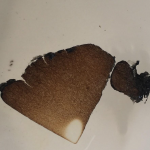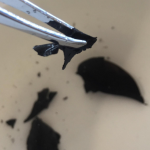by: Emily Yi Eun Woo
Paper flower craft is used as a substitution for flowers. It can be used to express various colors by dyeing, and it is easy to adjust the size, so it has been widely used in court feast, flower ceremony of Buddhist temples, and ceremonies of shamanic people. This flowers were often given to many officers of martyr and gradually passed around to the royal family and the common people. This has been used as a tool to dedicate Buddhist ceremonies such as Youngsanjae. Due to this, many called this flower the “God flower.”
Methods:
- Talk to a Korean Buddhist Monks studying in Columbia to ask their history and relationship with JiHwa Paper
- Ask Korean Department in Columbia for any literature based on flower crafts
- What kind of native flowers did Koreans have? Which flowers were made into paper? Was using flowers considered as decoration? Could lower class also decorate their house?
- Research different types of dyes used in Joseon Dynasty to choose what kind of dyes were used to dye hanji. Was there a different way to dye paper? How long did it take? What was the process like?
- Create different types of flowers following variety set of instructions from a person or a recipe
Test/Methodology Notes:
As the monk stated in the interview, she specifically noted that the glue was the most important ingredient to assemble the lantern but she also said that you could only make the glue by looking at it. There was no specific ratio but you instead you measured as you mixed the glue.
1 cup of water, ⅛ cup of rice (15 minute low heat boil)
- The edge of the paper took two dabs of rice glue to cohesively stick to each other
- 10 minutes later, the glue did try and come apart
1 cup of Water, 1 teaspoon of flour and ⅛ cup of rice (20 minute low heat boil)
- The edge of the paper only took 1 dab of rice glue to cohesively stick to each other
- The edges did not fall apart
1 cup of Water, 2 teaspoon of flour and ⅛ cup of rice (30 minute low heat boil)
- Similar to 1 teaspoon of flour, the paper took 1 pink of rice glue to cohesively stick to each other
- The edges did not fall apart after 10 minutes
- 30 minutes of rice boil caused the rice to fall apart while sieving so the glue was not as smooth as the 20 minute low heat boil but it did not get in the way of putting the glue on the edges
1.2 cup of Water, 2 teaspoon of flour and ⅛ cup of rice (35 minute low heat boil)
- The edges of the paper did not stick together
- The water made the glue too watery and there were more rice pieces in the way that the two papers could not stick to each other
Final Product:
 **This picture was taken after an 1hr of drying. According to the monk, the glue was supposed to be left drying for 2 days so the ones that stuck may unravel with time but after 1hr only the 1.2 cup of water version unraveled
**This picture was taken after an 1hr of drying. According to the monk, the glue was supposed to be left drying for 2 days so the ones that stuck may unravel with time but after 1hr only the 1.2 cup of water version unraveled
Prior knowledge that you have: Rice glue is an essential part of craft making in Korea. Throughout elementary school and middle school, a lot of craft making like mask making and collage making required rice glue made by the teacher. It is ideal glue because the natural adhesive quality of rice does not ruin the quality of paper and because it was viscous enough, the paper would not become runny or lose shape.
Reflection on your practice: Unfortunately, I did not have an iron calderon to make the rice glue. The perks of using an iron calderon would have been that the rice wouldn’t have easily stuck to the bottom of the pan. I had to keep watching the rice because the pan was too thin so it would have burnt easily. Yet, I tried different proportions of the ingredients to test out which level of viscosity.
Questions:
- How did the monks keep the flour from hardening? The monk said that there was a person who only made glue out of the whole craft making process. Does that mean the oral tradition could be only passed down by one person?
- Did monks have sifts? What alternative sifters could they have used? Or did they choose the option of grinding the rice into a powder before making the glue so that they did not have grains?
- What is the origin of rice glue? Is it from Korea? How was it used other than craft practice?
Date: 3/11/2017
People Involved: Me
Location: Barnard Dorm Kitchen (11Bth Floor Sulzberger Hall)
Environmental Conditions: Warm, a lot of sun during the day
Time and Duration of experiments: 1 hour and half
Equipment and tools used:
- Bowl of cold water
- Lighter
- Tweezer
- Labeling Tape
Materials and their sources and quantities:
- 4 Hanji 3×4 strips
- 4 A4 3×4 strips
- Rice Glue
Burning Hanji
- Hanji burned in a brown color and faster
- Floated in the water even after a burn
- The paper color was coffee brown after burned
- Did not leave broken pieces of ashes
- 3 seconds to burn completely
- The ash of paper was flimsy gray color and a bit translucent/ easily turned into powder grain
Burning A4
- Burned slower than Hanji
- The A4 paper curled inwards with a black color
- A4 sank into the bottom of the water completely
- When trying to lift it up from water, it crumbled into smaller pieces than Hanji (resembled dried seaweed/konbu)
- A4 burnt paper released brownish color that made the water slightly browner
- The burnt paper was much more easily destroyed and broken into pieces in the water than the hanji
- 39 seconds to burn everything
- The ashes were more powdery than the hanji and greyer (refer to video)
Hanji and A4 with Dried Rice Glue:
Burning Hanji and A4 with Rice Glue on it (1 hr under the direct sunlight) *please refer to videos
- Dried faster than Hanji by at least 10 minutes
- Wrinkled more than hanji
- 5 seconds to burn the similar flimsy gray color came out without the rice glue on it
- A small (size of a bead) brown ball came out (which im guessing its the remnants of the rice glue
Prior Knowledge that you have: none
Reflection on your practice: I thought it would be interesting to test out how fast the papers burn with rice glue on it because of the traditional lanterns. Every year on the day the birthday of Buddha, the temples hang hanji lanterns with fire lit inside. I don’t think the rice glue helps the paper from catching on fire but it does burn twice slower than the original speed without the glue.
Questions that arise:
- Even though it is dangerous to use light fire in a paper lantern but why was hanji used?
- Could hanji be made that it wouldn’t burn as quickly?
- What are the usage of hanji’s ashes?







